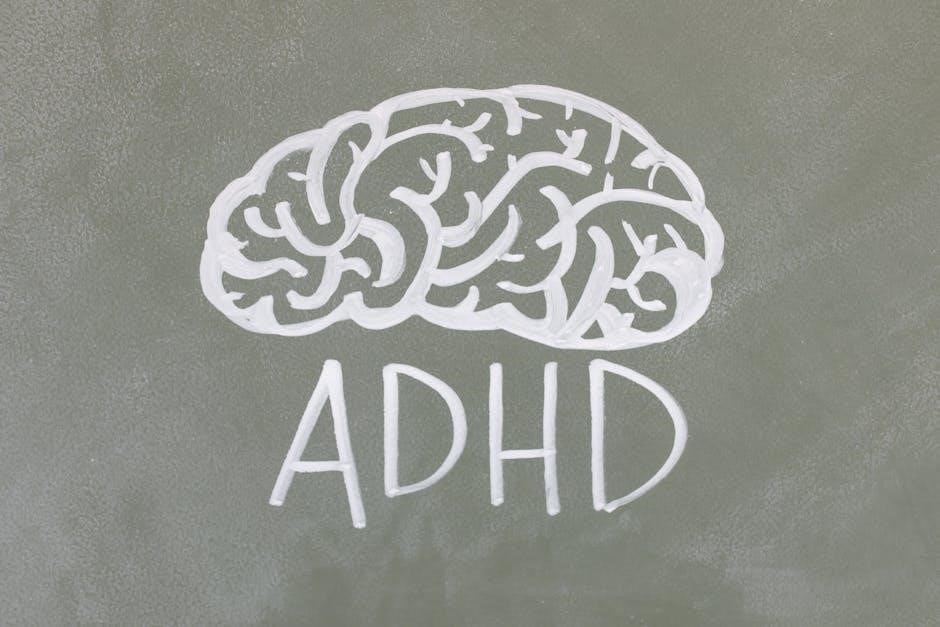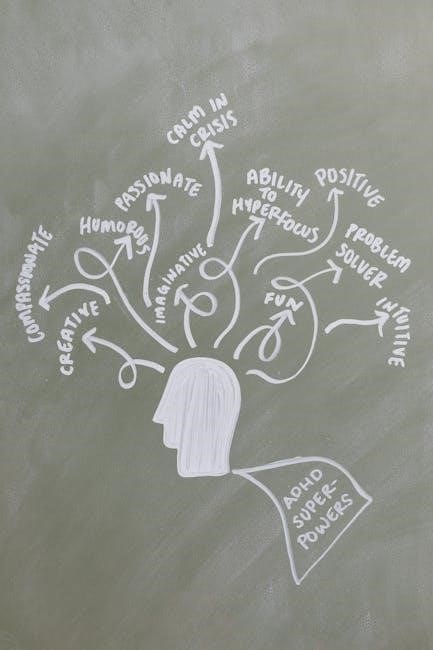The Conners Scale is a comprehensive assessment tool widely used to evaluate ADHD symptoms in individuals. It provides detailed insights into behavioral patterns and emotional regulation, aiding clinicians in accurate diagnosis and personalized treatment planning. The scale includes versions for parents, teachers, and self-reporting, ensuring a holistic evaluation across different settings. Its alignment with DSM-5 criteria makes it a reliable resource for understanding ADHD and related disorders.
Overview of the Conners Scale
The Conners Scale is a widely recognized assessment tool designed to evaluate symptoms of Attention-Deficit/Hyperactivity Disorder (ADHD) and related behavioral issues in individuals. It is available in multiple versions, including the Conners 4, which assesses ADHD, oppositional defiant disorder (ODD), and conduct disorder. The scale provides a comprehensive evaluation of behavioral patterns, emotional regulation, and cognitive functioning. It includes parent, teacher, and self-report rating scales, ensuring a holistic view of the individual’s behavior across different settings. The Conners ADHD Index specifically measures the likelihood of ADHD based on symptoms. Additionally, the Conners Comprehensive Behavior Rating Scale (CBRS) offers detailed insights into various childhood disorders. This tool is invaluable for clinicians, educators, and parents seeking to understand and address behavioral challenges effectively.
Importance of the Conners Scale in ADHD Assessment
The Conners Scale plays a crucial role in ADHD assessment by providing a standardized method to evaluate symptoms and behavioral patterns. It helps differentiate ADHD from other disorders with similar symptoms, ensuring accurate diagnoses. The scale is widely used by clinicians to assess the severity of ADHD symptoms in various settings, such as home and school. By aligning with DSM-5 criteria, it aids in identifying symptoms that must be present in multiple settings for a valid diagnosis. The Conners Scale also supports treatment planning by offering insights into specific behavioral challenges. Its comprehensive nature makes it an essential tool for monitoring progress and adjusting interventions. This scale is invaluable for clinicians, educators, and parents seeking to understand and manage ADHD effectively.

Structure and Components of the Conners Scale
The Conners Scale comprises multiple rating forms, including parent, teacher, and self-report versions, each assessing ADHD symptoms and related behaviors. It also includes the Conners Adult ADHD Rating Scales for adults, ensuring comprehensive evaluation across different age groups and settings. The scale incorporates DSM-5 criteria, providing a standardized framework for symptom assessment. The structure allows for a detailed understanding of an individual’s behavior, aiding in accurate diagnosis and treatment planning. Each component is designed to capture specific aspects of ADHD, offering a holistic view of the disorder’s impact.
Parent Rating Scales
The Conners Parent Rating Scales are designed to assess ADHD symptoms and related behaviors in children, as reported by their parents or caregivers. These scales evaluate various aspects of a child’s behavior, including inattention, hyperactivity, impulsivity, and emotional difficulties. The ratings are based on a 0-3 Likert scale, where 0 indicates “not true at all” and 3 indicates “very much true.” The parent scales are divided into specific indexes, such as the Conners 3 ADHD Index, which helps identify ADHD symptoms aligned with DSM-5 criteria. Additionally, the Conners 4 measures the likelihood of ADHD and other disorders like oppositional defiant disorder (ODD). Parents provide insights into their child’s behavior at home, offering a comprehensive view for clinicians to aid in diagnosis and treatment planning. These scales are essential for understanding a child’s behavioral patterns in a home environment.
Teacher Rating Scales
The Conners Teacher Rating Scales are a crucial component of the Conners assessment, designed to evaluate ADHD symptoms and related behaviors in a school setting. Teachers rate the child’s behavior on a scale from 0 to 3, assessing aspects such as inattention, hyperactivity, and impulsivity. These scales provide valuable insights into a child’s academic performance and social interactions, which often differ from home behavior. By capturing the child’s behavior in a structured environment, the teacher scales help clinicians make accurate diagnoses according to DSM-5 criteria. This information is also vital for creating personalized treatment plans that address specific challenges in the classroom. The combination of teacher and parent ratings offers a comprehensive understanding of the child’s behavior, ensuring effective interventions tailored to their needs.
Self-Report Rating Scales
The Conners Self-Report Rating Scales provide a unique perspective by allowing individuals to assess their own behaviors and emotional states. These scales are particularly useful for older children, adolescents, and adults, enabling them to share their experiences and perceptions. The Conners Comprehensive Behavior Rating Scale-Self-Report (Conners CBRS-SR) prompts individuals to evaluate symptoms such as inattention, hyperactivity, and impulsivity. This tool is especially valuable for identifying issues like emotional distress, anxiety, and conduct problems. The self-report format encourages honest self-reflection, offering insights into how individuals perceive their own behavior. By aligning with DSM-5 criteria, these scales help clinicians understand the severity of ADHD symptoms and related disorders. The combination of self-reports with parent and teacher ratings ensures a well-rounded assessment, fostering accurate diagnoses and effective treatment strategies.
Conners Adult ADHD Rating Scales (CAARS)
The Conners Adult ADHD Rating Scales (CAARS) are specifically designed to assess ADHD symptoms in adults. This tool evaluates key areas such as inattention, hyperactivity, and impulsivity, while also addressing emotional regulation and self-control. The CAARS includes both self-report and observer rating forms, allowing for a comprehensive understanding of an individual’s behavior. The self-report version enables adults to reflect on their own experiences, while the observer form provides an external perspective, often from a spouse, employer, or clinician. Scoring algorithms help determine the severity of symptoms and their impact on daily functioning. By aligning with DSM-5 criteria, the CAARS is a reliable instrument for diagnosing ADHD in adults and monitoring treatment progress. Its sensitivity to symptom changes makes it a valuable resource for clinicians in developing tailored intervention plans.

Assessment Process and Scoring
The Conners Scale involves completing rating forms by parents, teachers, or self-reports. Each item is scored on a 0-3 or 0-4 scale. Responses are analyzed to determine symptom severity, compared to normative data, and interpreted by clinicians to inform ADHD diagnosis and treatment planning.
Completion of the Rating Scales
The Conners Scale is completed by parents, teachers, or individuals themselves, depending on the version. Each rating form contains items assessing ADHD symptoms and related behaviors. Parents and teachers rate behaviors observed in the last month on a 0-3 or 0-4 scale. Self-report scales use similar formats but focus on internal experiences. All items must be answered to ensure accurate scoring. Clinicians guide respondents to provide honest, objective feedback. The process ensures comprehensive data collection across home, school, and personal settings. Proper completion is crucial for reliable results, aiding in diagnosis and treatment planning. Instructions emphasize considering age-appropriate behavior and medication status. Accurate ratings help differentiate ADHD from other disorders, ensuring targeted interventions.
Scoring and Interpretation of Results
The Conners Scale uses a standardized scoring system, with raw scores converted to T-scores or percentiles. Each item is rated on a 0-3 or 0-4 scale, reflecting symptom severity. Clinicians interpret scores against normative data, identifying elevations that align with ADHD criteria. The Conners 4-ADHD Index predicts ADHD likelihood, while other scales assess comorbid conditions like ODD. Results are compared to DSM-5 criteria, ensuring accurate diagnosis. High scores indicate significant symptoms requiring intervention. Interpretation guides treatment planning and monitoring progress. Clinicians use scoring sheets to summarize data, aiding in clear, actionable insights. The process ensures reliable, evidence-based decision-making for ADHD management and related disorders.
Role of Clinicians in Administering the Scale
Clinicians play a crucial role in administering the Conners Scale, ensuring its proper use and interpretation. They select the appropriate version of the scale based on the client’s age and circumstances, such as the Conners 4 or CAARS for adults. Clinicians guide respondents, such as parents or teachers, to provide accurate ratings by explaining the assessment’s purpose and instructions. They ensure the scale is completed in the correct setting, considering factors like medication use. After collection, clinicians score and interpret the results, comparing them to normative data. They assess symptom severity, identify patterns, and determine if criteria for ADHD or related disorders are met. Clinicians also integrate scale results with other diagnostic tools to ensure a comprehensive evaluation, making informed decisions for diagnosis and treatment planning.

Diagnosis and Treatment Planning
The Conners Scale aids in diagnosing ADHD by assessing symptoms and helps develop targeted treatment plans, ensuring personalized interventions and monitoring progress effectively.
Role of the Conners Scale in ADHD Diagnosis
The Conners Scale plays a pivotal role in ADHD diagnosis by providing standardized assessments of symptoms across various settings. It evaluates behavioral patterns, inattention, hyperactivity, and impulsivity, aligning with DSM-5 criteria. The scale’s multi-informant approach—gathering insights from parents, teachers, and self-reports—ensures a comprehensive understanding of an individual’s symptoms. Clinicians use the scale to differentiate ADHD from other disorders, such as oppositional defiant disorder (ODD) or conduct disorder, by analyzing the Conners 4-ADHD Index. This tool helps determine the likelihood of ADHD, offering a reliable foundation for accurate diagnosis. By capturing symptom severity and impact, the Conners Scale supports clinicians in making informed diagnostic decisions, ensuring appropriate interventions for individuals suspected of having ADHD.
How the Scale Assists in Developing Treatment Plans
The Conners Scale significantly aids in creating personalized treatment plans by identifying specific symptom severity and behavioral patterns. It helps clinicians pinpoint target areas for intervention, such as inattention or impulsivity, and monitor progress over time. The scale’s comprehensive data enable healthcare providers to tailor strategies to the individual’s needs, ensuring a focused approach. Additionally, the Conners Scale facilitates collaboration between clinicians, educators, and families by providing a shared framework for understanding the individual’s challenges. This alignment ensures consistency in implementing interventions across different settings. By offering clear insights into symptom impact, the scale supports the development of effective, adaptive treatment plans that address the unique needs of each individual with ADHD.
Monitoring Progress and Treatment Adjustments
The Conners Scale plays a pivotal role in monitoring progress and adjusting treatment plans for individuals with ADHD. By regularly administering the scale, clinicians can track symptom changes over time, identifying improvements or areas needing further intervention. The detailed reports generated from the scale provide actionable insights, enabling healthcare providers to refine treatment strategies based on ongoing assessment. This iterative process ensures that interventions remain effective and tailored to the individual’s evolving needs. The scale’s ability to assess behavior across multiple settings further supports consistent monitoring, helping to adjust therapies or medications as necessary. This continuous feedback loop is essential for optimizing outcomes and ensuring long-term management of ADHD symptoms.

Related Scales and Comparisons
The Conners Scale is often compared to other tools like the Vanderbilt Parent and Teacher Assessment Scales and the ADHD Rating Scale (ADHD-RS). These scales provide similar insights into ADHD symptoms but differ in focus and administration methods. The Adult ADHD Self-Report Scale (ASRS-v1.1) and the Conners Comprehensive Behavior Rating Scale-Self-Report (Conners CBRS-SR) are also used for self-assessment. Each tool offers unique perspectives, enabling a more comprehensive evaluation of ADHD symptoms and related behaviors. They complement the Conners Scale by providing additional data for accurate diagnosis and treatment planning.
Vanderbilt Parent and Teacher Assessment Scales
The Vanderbilt Parent and Teacher Assessment Scales are widely used tools for evaluating ADHD symptoms in children. These scales assess behaviors such as inattention, hyperactivity, and impulsivity, aligning with DSM-5 criteria. Parents and teachers rate the child’s behavior over the past month using a scale from 0 (not a problem) to 3 (very often). The Vanderbilt scales are often used alongside the Conners Scale to provide a more comprehensive view of a child’s behavior across different settings. They are particularly useful for diagnosing ADHD and monitoring treatment progress. The scales also include items assessing emotional and behavioral difficulties, making them a valuable resource for understanding comorbid conditions. Their structured format ensures consistency and reliability in assessing ADHD symptoms.
ADHD Rating Scale (ADHD-RS)
The ADHD Rating Scale (ADHD-RS) is a widely recognized tool for assessing ADHD symptoms in children and adults. It evaluates the presence and severity of ADHD symptoms based on DSM-5 criteria, including inattention and hyperactivity-impulsivity. The scale typically consists of 18 items, with each symptom rated on a 4-point scale from 0 (none) to 3 (severe). The ADHD-RS is often used in clinical and research settings to monitor treatment responses and track symptom changes over time. It is valued for its brevity and focus on core ADHD symptoms, making it a practical choice for both initial assessments and ongoing evaluations. The scale’s simplicity and alignment with diagnostic criteria ensure its effectiveness in identifying and managing ADHD across various populations. Its widespread use underscores its reliability and utility in both clinical practice and research studies.
